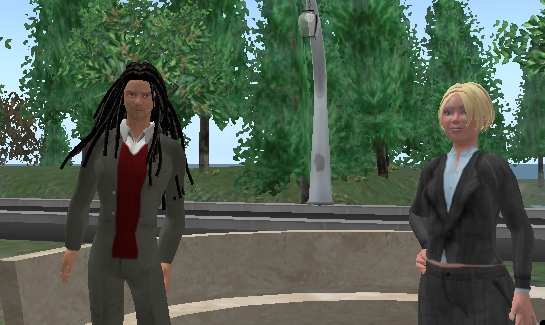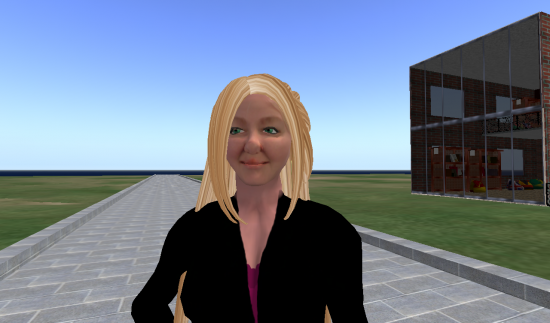When business users first log into a virtual world like Second Life or OpenSim they usually have two questions: can they use their real names for their avatars? And can their avatars look like them?
The answer to the first question is simple. In OpenSim, users can choose any names they want, as long as they’re not already taken. And if a name is already taken on one grid, there are plenty of other grids to try. In web terms, this is like finding out that john.smith@gmail.com is taken, and trying john.smith@hotmail.com and john.smith@yahoo.com.
When you walk around on that grid, your name would show up in chat and over your head as “John Smith,” and, when you travel to other grids, as “John.Smith@somegrid.com:9000” where “somegrid.com” is the URL of the grid, and 9000 is the port used to access the virtual world.
Real names in Second Life are not allowed. According to Chris Collins, Linden Lab’s general management for enterprise, the best a person could do is to have their company name as their last name, and squish their first and last names together into the first name: “JohnSmith AcmeCorp.”
There are also devices you can get that will float your real name over your head, a kind of walking banner of your real identity.

“You can see the device that I have over my head, that shows my name and my company name,” he said. And he did, in fact, have one.
Real faces in Second Life — and in OpenSim — are plagued by a different problem. And that is the fact that the way faces work is by stretching an image over a three-dimensional model of a head. It’s possible to upload an image adapted from an actual photograph of your face — but there is currently no way to import the shape of your head that goes with it.
The best known service for importing faces is CyberExtruder‘s avatar maker product, available both as a service on its website, as a product available on Second Life’s Avatar Island, and as standalone software.
This week, I downloaded the software to try it out.
The best results came from a professional headshot I had taken a couple of years ago. Unfortunately, I’m smiling in the photo, which throws the results off a bit — a bland, neutral expression works best, said CyberExtruder’s chief operating officer, Jack Ives.

With my studio headshot, the software was able to instantly identify the contours of my face and generate a very realistic three-dimensional model of my head, sans hair. I could turn it around and look at it from all directions.
I also tried a digital camera picture in which my hair was pulled back and I had my mouth closed — but because my head was slightly askew, or maybe for other reasons, I had to manually adjust the contour lines that mapped my face. This took about fifteen minutes of fiddling — and the resulting three-dimensional model didn’t look as good.
But I was happy with the first one, and I shelled out the $10 for ten avatars that the company is currently running as a promotion.

Normally, one avatar costs $10, two avatars cost $15, and three avatars cost $20. There’s also a bulk discount for enterprises needing to produce 1,000 avatars or more. For companies that need something in the middle, Ives suggests contacting the company directly. “We would put something together for you,” he said.
But I don’t know how these companies do it. The whole process took me over an hour, and it was frustrating.
After I paid my money, got my access code, and downloaded my avatar — face texture, torso texture and leg texture all matching the skin tones on my face — I had to upload them individually into my OpenSim account.
The process would be the same for Second Life, except that the upload would cost you a little money, and is free in OpenSim.
But after I uploaded the textures and glued them to my avatar, that’s when the hard work began. Because it turns out that my avatar’s nose wasn’t shaped the way mine was. And the eyes were off — the eyes weren’t imported along with the rest of the avatar.
I spent half an hour fiddling with the settings — making my face a little wider, then a little narrower, my chin a little bigger, then a little smaller, the eyes a little greener, then a little bluer, before I gave up.
The end result is vaguely like me — but not so as to be recognizeable.

I can’t imagine doing this for 1,000 employees.
“Larger companies that want to have many hundreds or thousands of users that need to be processed are still out of luck,” admitted Ives. “We have a development project on the roadmap — at the behest of one such company — to close the gap to a truly, fully automated avatar creator that will also generate the shape.”
One problem, he said, is that neither Second Life nor OpenSim currently allow shape imports. It is possible to automatically create a program that adjusts the shape for you, but these adjustments don’t necessarily correspond to particular aspects of a three-dimensional mesh-based object, he said.
“This is kind of an involved process,” he said.
- Kitely Mega Worlds on sale for $90 per month - July 19, 2024
- OpenSim regions up, actives down with summer heat - July 15, 2024
- People think AIs are conscious. What could this mean for bots in OpenSim? - July 12, 2024
